Coming Full Circle
The 2017 LTC International Convening
It was November in downtown Los Angeles, and returning to the Los Angeles Theatre Center (LATC) brought back layers of memories for both of us. We joined over two hundred and sixty participants as Scholars in Residence for an International Convening (9-12 November 2017), hosted by the Latinx Theatre Commons (LTC), as part of the 2017 Encuentro de las Américas International Theatre Festival. The Convening, a four-day event situated in the middle of the three-week festival, brought together theatremakers and scholars from the Américas. Expanding the circle of the over eighty Latinx theatre practitioners and scholars who first came together in Boston in 2013 to launch the LTC, the Convening signaled, among other things, that the LTC has evolved from its early maturation stage to a substantive, influential movement that has hosted seven events in four years, this being the first international foray. Participants came together to witness theatre and performance produced by fourteen Latinx and Latin American companies and solo artists (eight from the US and six from the Americas, including Canada, Central and South America, and the Caribbean), as well as to meet in larger group sessions and small groups. The programming for the Encuentro was bold; inspirational and aspirational, the breadth of productions traversed genres of storytelling, aesthetics, and theatricality. The gathering represented not only the growth of the LTC but new directions in the identity of Latinx theatre.
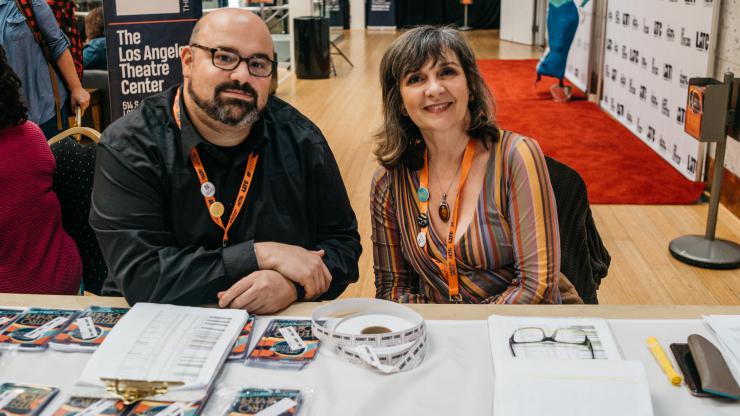
What was made evident at the Convening was that, alongside the celebration of our commonalities across Latinx, Latin American, Central, and South American theatre, there is a need for a productive and generative space to attend to our differences, ranging from the linguistic to the aesthetic to the representational to the structural. If the LTC is to continue to create programming that confronts, as Brian Eugenio Herrera notes, the “colorism and other divisions within Latinx communities and theatremaking traditions” and “to dig deeply into the problems of erasure, elision, and exclusion,” then the Convening, while it was an important, necessary, and vital space to continue this work, was just the beginning. Our documentation of the Convening is a call for all those involved in the LTC to reflect, advocate, and develop the LTC’s core value of “radical inclusion.”
What was made evident at the Convening was that, alongside the celebration of our commonalities across Latinx, Latin American, Central, and South American theatre, there is a need for a productive and generative space to attend to our differences, ranging from the linguistic to the aesthetic to the representational to the structural.
In what follows, we describe what was voiced, what we witnessed transpire, and identify some areas for growth as a result of the 2017 Convening at the Encuentro de las Américas, when artists, practitioners, and scholars came together to bridge languages, cultures, theatrical styles, and continents in a conversation about theatremaking and Latinidad.
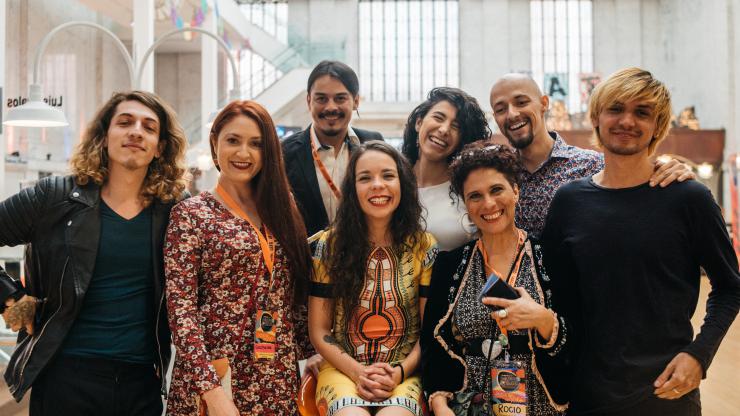
Gathering Space
The site of the Encuentro at the LATC emphasized the centrality of Latinx culture in Los Angeles, and the LATC’s presence in the larger theatre community. In his Encuentro de las Américas Manifesto, delivered during the opening ceremonies, José Luis Valenzuela, the Artistic Director of the LATC, remarked on how LA is one of the most culturally diverse cities in the world, with 51 percent of the city comprised of Latinxs. The ability to house thirteen theatre companies was enabled by the Latino Theater Company, which operates the LATC, an eight-story facility in downtown LA featuring five theatres, two dance studios, and a large rehearsal space. The LATC represents US Latinx theatre as an undeniable force in Los Angeles, and the history of Los Angeles invokes not only the fraught relationship of Latinx people in the city, but also the violent colonial history of the US Southwest. Indeed, the convening participants were asked to honor the original inhabitants of this land during the opening of each large group session, with Melissa DuPrey offering a blessing for the opening ceremonies that included asking participants to speak the names of their ancestors, and Abigail Vega, LTC producer, invoking this blessing at the beginning of each large session: “We want to begin by acknowledging and thanking the original caretakers of the land we are standing on, the ancestors that came before us. We acknowledge that we are on the traditional territory of the Tongva, Gabrielino, Chumash, and the Ipai peoples, and many others for whom this land was a communal gathering space.”
The towering edifice of the LATC allowed the Convening to take place wholly inside one building. Small groups and optional break out session cafecitos were held in the lobby, conference rooms, and meeting spaces throughout the building, sending participants through hallways and elevators not open to the public. The Convening was a collaborative exploration of space within and outside the building, facilitated by the LTC’s arranging group reservations at nearby restaurants that participants could sign up for in order to meet people they did not know. Each morning, participants had coffee and breakfast in the vast space and couches of the historical grand lobby that by afternoon served as the meeting space between shows and the dance floor for live entertainment in the evening (which featured talented singer/songwriter Eddika, the electrifying bomba band Cunyá, and eclectic Latin Jazz Band from CalArts). The closing dinner was a catered event in the lobby where everyone dined in one space, together.
Looking Beyond the US
The shows produced during the Encuentro from 2 November through 19 November indicate LTC’s vision to look beyond the US to “activate international networks among Latinx theatremakers hemispherically.” Over the three weeks, the fourteen theatre companies and solo artists performed over multiple weekends and participated in their own artistic sharing through a collaborative devised rehearsal process. Although conveners met for a long weekend, the theatre companies had this three-week residency at the LATC as part of their artistic exchange. Artists were integrated into the Convening, though their rehearsal and performance schedules did not always permit full attendance. Some international artists were met with more than usual visa issues and arrived later than planned, causing shows to be canceled and the festival schedule rearranged. Although Valenzuela noted the difference between an encuentro and a festival—that an encuentro is “an encounter of thoughts and ideas, of creativity and discussion”—the Convening was largely shaped and influenced by the festival atmosphere, with changes in show times, international artists, the move beyond theatre to include spoken word, dance-type performance, a wealth of live music, and one unexpected fire alarm that reminded us of the liveness of the theatre.
The Shows at Encuentro
The shows presented during the Encuentro represented the variety and eclecticism of US Latinx, Latin American, and South American theatre. During the LTC International Convening, the participants had the option of attending up to nine shows alongside the other convening activities; other shows were offered throughout. Noteworthy aspects of the productions varied from narrative structure, theatrical props and effects, and dramaturgy. El Apagón (Pregones Theatre, Bronx, NY) showcased a bilingual and music-infused production and the power of storytelling with two actors, a live band, and little else onstage. Similarly, Conjunto Blues (Guadalupe Cultural Arts Center, San Antonio, TX) offered a semi-autobiographical narrative mixed with larger social narratives performed by one actor and a guitarist. By contrast, the Mexican odyssey of Quemar las Naves: El Viaje de Emma (Organizacíon Secreta Teatro, Mexico City, Mexico) illustrated the possibility of a highly-visual play without words to convey developed characters and plot. Participants showed up for Broken Tailbone (Nightswimming, Toronto, Ontario, Canada) to have Carmen Aguirre turn the audience into dancers for the full ninety minutes and move their bodies to music as she narrated a story intertwined with the legacy of refugees, dancing, and sexuality. Likewise, those who attended the Saturday morning production of Miss Julia (Vueltas Bravas, Bogotá, Columbia) were greeted by the vivacious drumming and party sounds of the live musicians, as well as shots of rum, before a highly stylized bilingual rendition of Strindberg’s classic.
With the eclecticism of solo performance, performance troupes, small and large casts, dream sequences, live music, dance and spoken word, adaptation, political drama, historical fiction, and old and new work, the Encuentro exhibited that there are no boundaries to Latinx theatre and performance.
Long-standing Los Angeles performance troupe Culture Clash performed Culture Clash: An American Odyssey, a series of vignettes addressing the border, gender non-conformity, and featured an impersonation of disgraced Arizona sheriff, Joe Arpaio. San Francisco-based Marga Gomez performed Latin Standards, which shifted queer Latinx solo comedic performance that historically was relegated to alternative performance spaces into the established space of the LATC. Colombian theatricality, from breaking the fourth wall to drag to puppetry, was on full display in Las Mariposas Saltan Al Vacío (Compañia Nacíonal De Las Artes, Bogotá, Columbia), and 24th Street Theatre in Los Angeles presented La Razón Blindada, a riff on Quijote and Kafka that involved a two-man show with a limited quantity of props that extended the imagination and intricate choreography largely performed while seated.
Ropa Intima (Ébano Teatro, Lima, Peru), a Lynn Nottage play, showcased Afro Latinx actors; their staging was a testament to the need for more work from a wider demographic of Latinx playwrights. 10 Millones (Argos Teatro, Havana, Cuba) presented a historical look at the repercussions of the volatile period of the 1970s and 80s in Cuba and Dementia (Latino Theater Company), originally premiered in 2002, brought audiences back to an early stage in the AIDS epidemic. Infusing technology into a story about DREAMers, Deferred Action (Cara Mía Theatre, Dallas, TX) enacted a searing commentary on the volatility of the contemporary political moment. The one-man show WET: A Dacamented Journey (Alex Alpharaoh/Ensemble Studio Theatre, Los Angeles, CA) infused hip hop to amplify the trials and tribulations of one DREAMer navigating a broken U.S. immigration system. With the eclecticism of solo performance, performance troupes, small and large casts, dream sequences, live music, dance and spoken word, adaptation, political drama, historical fiction, and old and new work, the Encuentro exhibited that there are no boundaries to Latinx theatre and performance.
Coming Together
After the opening statements from Melissa DuPrey, Abigail Vega, and José Luis Valenzuela, the Opening Ceremonies began with Jamie Gahlon, Teresa Marrero, Alex Meda, and Daniel Jáquez, all members of the programming committee, welcoming everyone and establishing both the rules and the intentions of the Convening: be a good collaborator, come from grace, and place an emphasis on listening. The committee also emphasized the crossroads of participants’ stories: “We all live at different intersections” and “we want to uplift diversity of experiences and ethical practice of our storytelling.” The opening centered a space beyond allyship and advocacy; this was about healing and community.
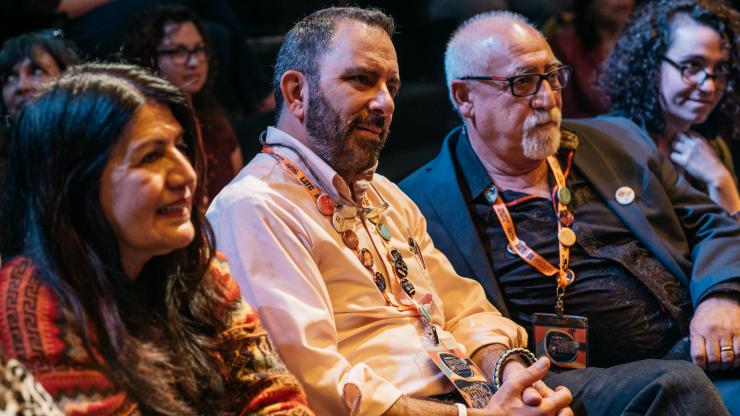
All two hundred and sixty-two people in the room were then invited to come to the stage and introduce themselves in ten words with name, city, and appropriate gender pronouns. Pronouns pins were available at registration, with options of “she/ella,” “he/el,” and “they/ustedes.” In a coordinated movement, each person walked to the microphone, and identity markers varied from informative to descriptive to comedic, from Melissa Duprey’s “she/hers/queen” to another speaker’s “no gender—it’s gay” to Marga Gomez’s “ho, hoes, homes.”
Maya Malan-Gonzalez and Marissa Chibas had the group take three breaths and visualize our ancestors, asking participants to “visualize … all of those people who have made it possible for you to be in this room right now right here. Honor them and feel their presence. Know that they have your back. We are all here for the same reasons but we are so diverse.” Malan-Gonzalez and Chibas then invited everyone to the stage. Marking the floor as a map, participants were told to stand where they were from. Then everyone moved to the place they call home. Upon doing this, the participants created a visual map, coming together in concentric circles. Participants were then told to “Look left. Look right. Look in front, behind.” The concentric circles came together, forming a metaphor of movement and call for unity for our work over the next days. Participants were encouraged to reach out, to make circles, and expand. The Convening had begun.
Language
Representing the bilingualism of the Convening, all large group sessions were simultaneously interpreted in English and Spanish. At the opening ceremony, Vega acknowledged the translators, sitting at the back of the room, and when José Luis Valenzuela followed, he began to speak in Spanish. This language shift from English to Spanish marked a recurring theme of the weekend: language differences will not inhibit us from communicating with each other across regions and countries. Throughout, there were calls to not to value Spanish as an authentic signifier of Latinx identity, and to include sign languages, Portuguese, and indigenous languages. In the Scholars’ Circle cafecito, when asked where we wanted Latinx Theatre scholarship to be in five years, Teresa Marrero said that it should “cross the language barrier” and another participant called for the greater use of ethnography as a methodology. In the second large group session, Jorge Huerta spoke of the continued need to document theatre in Spanish and English. And, in one of the small groups, moderated by Chantal Rodriguez and Marci McMahon, participants remarked on the structural factors leading to the lack of Spanish use by US Latinxs, leading Jorge Cao, director of Las Mariposas Saltan Al Vacío, in the group, to remark that the tension in US Latinxs’s relationship to Spanish was palpable, encouraging everyone to be generous with one another and mindful of colonial relationships of power that shape one’s ability to speak Spanish or English. Asserting resistance to hegemonic forms of language, in the final large group session, Chilean-Canadian performer Carmen Aguirre said, “To have a broken accent is an act of bravery.”
The Concentric Circles: Small Groups and Cafecitos
One hallmark of the Convening was the small group sessions and cafecito conversations that illuminated the range of viewpoints on a particular topic. All participants were assigned to small groups that met three times throughout the weekend, each one moderated by LTC Steering Committee members. These groups became the inner-most concentric circle, meeting three times throughout the Convening so as to create a more intimate atmosphere for dialogue and reflection amidst the larger sessions and performances attended. These small groups, each assigned the name of a music or dance style from across the Américas (such as mariachi, cumbia, joropo, bachata, and huayano) became a place for more intimate and—often—honest dialogue that demonstrated the different perspectives of the Convening experience.
The Scholars’ Circle cafecito involved over sixty participants who teach, research, or are affiliated with a university. In smaller groups within the cafecito, much of the conversation turned to issues of legibility in the United States, from journal placement to publishing in English versus Spanish, to public scholarship. In the Friday morning Translation cafecito, more than twenty-five people attended to discuss the imperative for translating plays and the biases, challenges, and potentialities for translation. Could bilingual playwrights be matched with Central and South American playwrights to help translate their work? Along with traditional issues about publishing and funding for translation work, most of the emphasis was on partnership: connecting with theatres and translation as a team project across playwrights, actors, and/or directors. The Theatre for Young Audiences cafecito on Friday, moderated by Roxanne Schroeder-Arce and Mateo Hernandez, represented a large and diverse interest by conveners in theatre for youth, and was a generative space for networking in advance of the January 2019 LTC Convening at the TYA Sin Fronteras Festival in Austin, Texas. In a Saturday morning cafecito on Collaborating with Universities, the conversation centered on questions of funding, artist residencies, and creating an online repository of plays and performances.
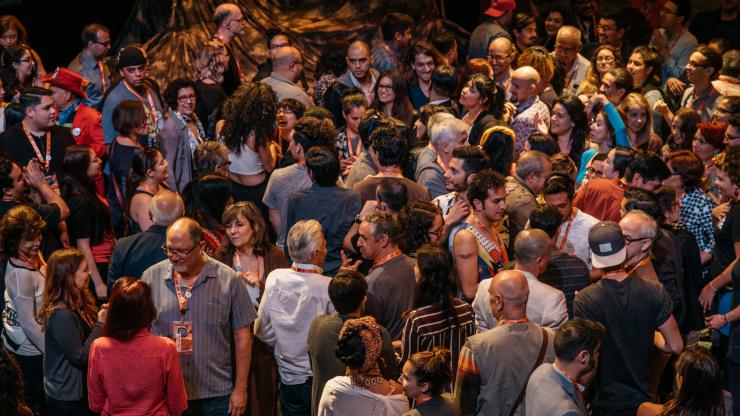
The Large Group Sessions
The first large group session, “Current and Emerging Trends in Theatre of the Americas,” brought together regionally diverse theatre practitioners across the Americas to address the state of Latinx theatre today and identify trends. Teresa Marrero moderated the first part of the session, which included six theatre professionals speaking to current and emerging trends in the Theatre of the Americas, including Canada, Spanish-speaking Latin America, and the United States. The speakers addressed how they work both in their own communities and across borders to amplify the work of Latinx and Latin American artists. Colombian-American scholar and producer Beatriz Rizk spoke in English about cultural trends, explaining that images are no longer the doubles of things, but the things themselves. Mexican producer Andrés Naime spoke in Spanish about audience expectations. Colombian university instructor Roberto Garcés Figueroa talked about the high value on foreign plays in Colombia, and Claudia Villegas-Silva from Arizona State University addressed multi-generational identities. Chilean-Canadian director Marilo Nuñez addressed the complexity of race and Latinx identities in Canada, and Diane Rodriguez spoke about trends in theatre-going and the economics of a sustainable theatre practice.
During the second half of the session, which was the result of an “open call” to participant conveners, thirteen practitioners from different regions across the Americas shared their insights into creating Latinx and Latin American theatre. Maritxell Carrero spoke of the need to create alliances based on her experience as an artist after the recent hurricane in Puerto Rico. rebekah tarín of Penasco Theatre Collective in Albuquerque, New Mexico spoke about intergenerational and intersectional theatre practices, proclaiming, “We are intergenerational, non-hierarchical, trans, Jewish, operating from places of strengths, seemingly to visibilize our existence. We are constructing a different table that has a large longitude and latitude. Anti-patriarchal, resilience strategies, community building, alliance building…. We honor collaborative practices, cultivate voices.” Clyde Valentín from SMU’s Ignite Arts Dallas stressed that theatre can create social change and suggested that ensemble work can bring food to people, saying, “What if instead of Whole Foods we had grocery stores that were also cultural centers?” José Torres-Tama performed his spoken-word activism, proclaiming and repeating, “Ningun hermano es ilegal. No brothers are illegal. No human being is illegal,” culminating his performance with “Europeans were the first illegals. No guacamole for immigrant haters.” Patricia Herrera, scholar and theatre practitioner at the University of Richmond, spoke about the importance of disrupting a masculinist historical narrative in our theatre work and making the labor of Latinx and Afro Latinx women artists visible through documentation, theatre, scholarship, and archives, proclaiming, “If not, white supremacy will continue to be intact.” Tiffany Ana Lopez, Director of the School of Film, Dance, and Theatre at Arizona State University, spoke of the urgency to document our theatre work and urged every theatre company in attendance to maximize this moment by networking with scholars and offered the idea that every theatre needed a “scholar in residence,” proclaiming “the biggest resource is our educators.” Yenny Sanchez of Baca Teatro in Colombia invited others into her dance performance to illustrate the importance of collective theatre making. Mario Cantú Toscano, Lillian Manzor, and Jorge Huerta also commented on the need for documenting theatre. This panel brought forth the multitude of reasons for theatremaking, and the imperatives each group faces for building community, developing artistry, and writing Latinx theatre history.
The second full group session, “Sensory Strategies: Festival Artists In Conversation,” moderated by Chantal Rodriguez, staged a dialogue with Encuentro artists to probe their aesthetics, process, and how their local communities influence their work. Artists were invited to reflect on their companies’ aesthetics and how artistic influences impact their work. Nicolas Valdez, author/performer in Conjunto Blues, traced the history of Mexican American teatro in Texas to the carpas, or traveling tent shows. He invoked how the Guadalupe Cultural Arts Center was founded on the activist teatro generated by El Teatro Campesino, with aesthetics driven by a lack of resources, reflected in the rasquachismo of the shows, with work driven by documenting the history and culture of Mexican Americans in Texas. Rosalba Rolón, artistic director of Pregones Theatre, spoke to the urgency of creating theatre, connecting the origins of Pregones to 1970s street theatre, noting that the first production was a staged reading in a member’s apartment; she spoke to the collective and multiple voices informing the work, proclaiming, “If not theatre, we want to turn it into theatre.” Carmen Aguirre of Nightswimming Theatre in Toronto, Canada, and author of Broken Tailbone, spoke to her work as being “unabashedly political” and coming from the importance of documenting, from her own positionality as a Chilean refugee in Canada, the refugee experience in contrast to the immigrant experience. Alicia Olivares, producer of Ebano Teatro’s Ropa Intima, which she also acted in, spoke of the influences of African American Theatre in Peru. In addition to aesthetics and process, the panelists spoke about economic constraints and the need for more artistic exchanges and collaborations, with Rolón of Pregones asking at the end, “How can we make these inter-exchanges viable?”
The final large group session on Sunday gave voice to the takeaways from the smaller groups (See Olga Sanchez Saltveit’s “Estamos Juntos / We are Together”). For the final large session, small groups were asked to reflect on “What still needs to be said? Where do we go from here?” Each group had two minutes to respond, and responses ranged from performance skits, musical pieces, and spoken word and varied in the range of issues addressed. This series of presentations brought the large group together with the reggaeton group closing the session with the proclamation “Estamos Juntos.”
The Convening’s expansion of the circle outward across continents caused each of us to look inward. While there was theatremaking, celebration, networking, and reflection at the 2017 LTC International Convening, as practitioners and scholars of Latinx, Latin American, Central, and South American theatre, we must continue to not only create spaces for deep reflection but to create programming that activates radical inclusion in Latinx theatre across the Américas.
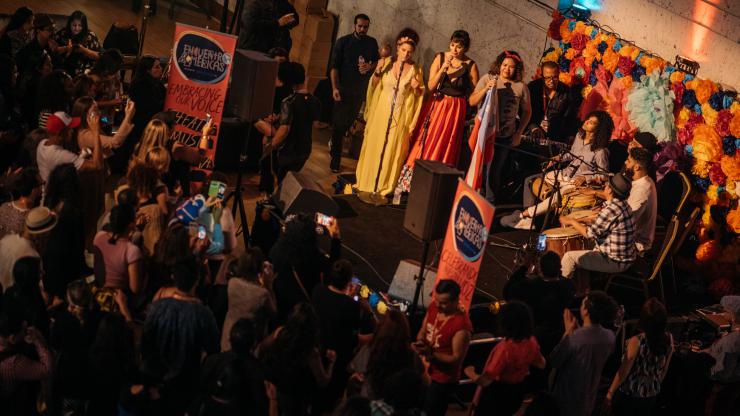
Commons vs. Differences
It became clear at the Convening that the challenges we are facing can be quite similar or wholly different. In Alberto Sandoval-Sánchez and Nancy Saporta Sternbach’s 2001 seminal book, Stages of Life: Transcultural Performance & Identity in U.S. Latina Theater, they characterized the different generations of Latinx theatre thematically, and they addressed generational change as one of the key themes characterizing Latinx theatre. Coming full circle over fifteen years later, the issue of generational divide was made explicit at the Convening and played out more so in conversations about theatremaking than as a subject matter within the storylines of the productions. Even as the LTC strives to remain nimble and adaptive to the ever-changing political climate and arts field, it became evident that some convening participants viewed some of the choices of the LTC as establishment. The Encuentro showcased long-established US theatremakers, all of which have existed for at least twenty years and represent to a younger generation a stronghold on Latinx theatre. With the call for the “elders” to step aside to make room for the “millennials” balanced with Diane Rodriguez’s question of how we can make a long-term career (and living) in the theatre, the convening opened up the question of how to put generations in dialogue and how to share space across cultural differences beyond those of nation and ancestry but also of technology and community.
Great care was taken to attend to gender inclusivity, with pronouns asked of participants during the online application process and gender-designation buttons available at registration. With the name shift from the Latina/o Theatre Commons to the Latinx Theatre Commons, and the work at every convening and communication towards gender inclusivity, there is much to celebrate with the LTC as a model for equity, diversity, and inclusion. Despite this effort, some conveners felt there was little genderqueer, transgender, and gender non-conforming representation onstage, even less representation of non-heterosexual relationships, and were concerned about no gender-neutral restrooms designated in the building. Some expressed how the Convening did not offer enough space in the schedule for addressing issues of representation in certain productions in conversation and critique. In a similar vein, some conveners expressed anticipation of future events with programming that includes more mixed race and Afro Latinx peoples. The Convening demonstrated that we can come together as artists and scholars across nationalities and languages, but it also showed that when together, we cannot just reflect and share. We have the responsibility to advance the conversation and the actions taken toward equity and inclusion.
Conclusion
The productions, the large group sessions, the small groups, the cafecitos, the hallway encuentros, the lobby gatherings, and late-night parties throughout the weekend represent the myriad of exchanges and spaces of the Convening. The Convening’s expansion of the circle outward across continents caused each of us to look inward. While there was theatremaking, celebration, networking, and reflection at the 2017 LTC International Convening, as practitioners and scholars of Latinx, Latin American, Central, and South American theatre, we must continue to not only create spaces for deep reflection but to create programming that activates radical inclusion in Latinx theatre across the Américas. The Convening charges us to continue to build on LTC’s foundation of empathy and inclusion to model radical inclusion and equity. The LTC is ready.

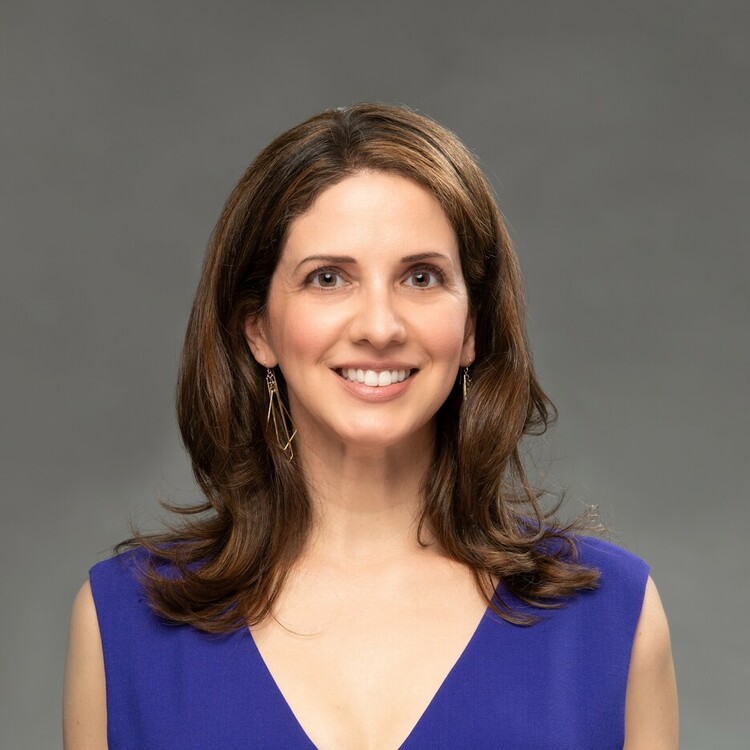
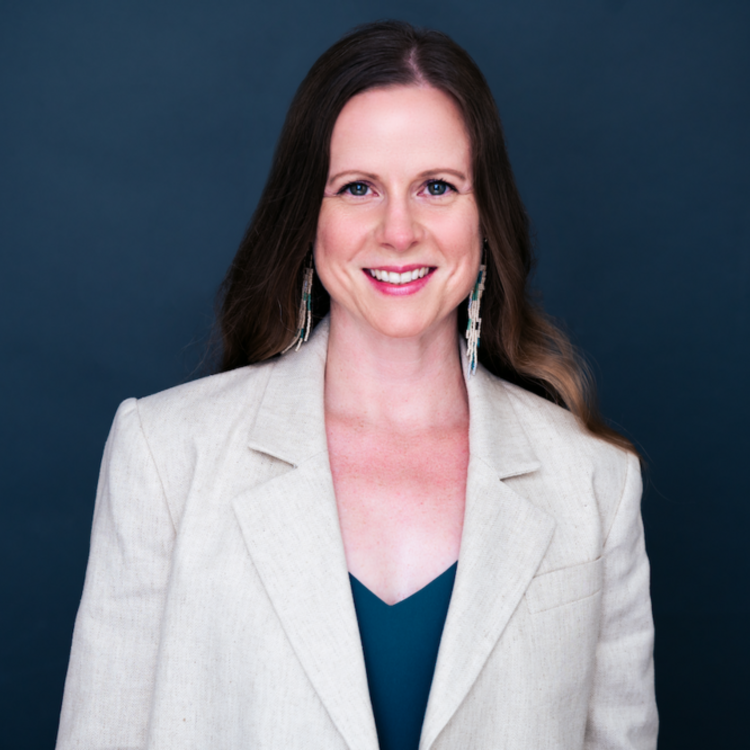


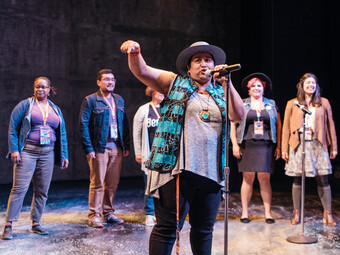



Comments
The article is just the start of the conversation—we want to know what you think about this subject, too! HowlRound is a space for knowledge-sharing, and we welcome spirited, thoughtful, and on-topic dialogue. Find our full comments policy here